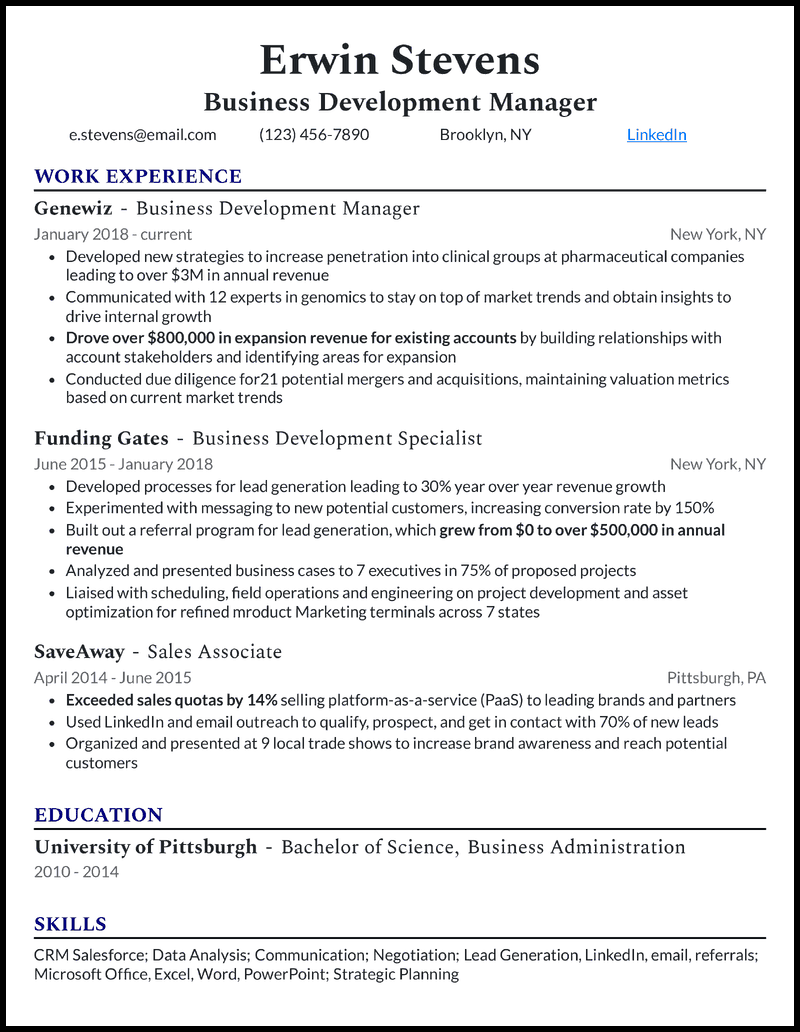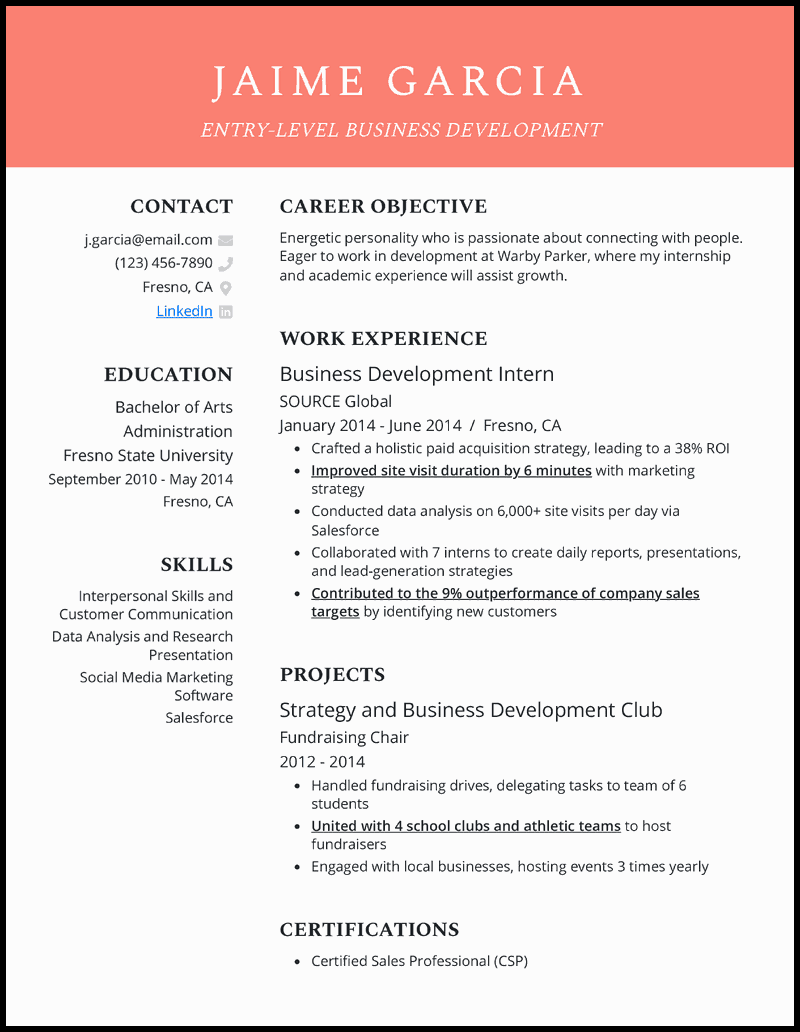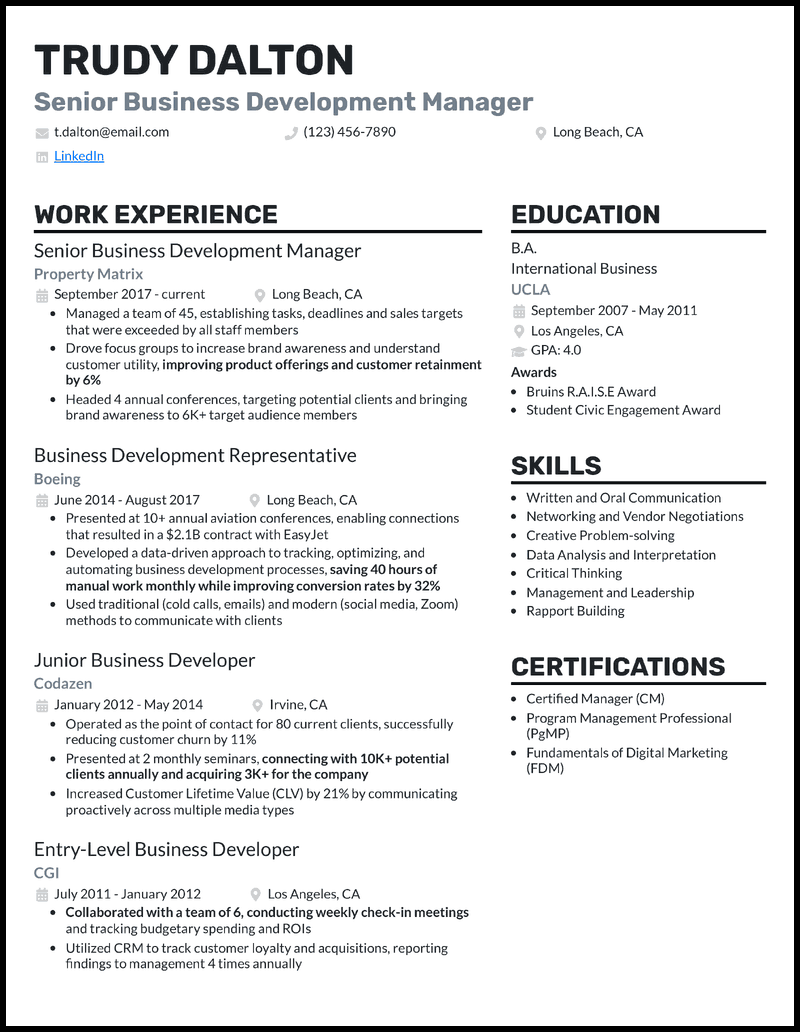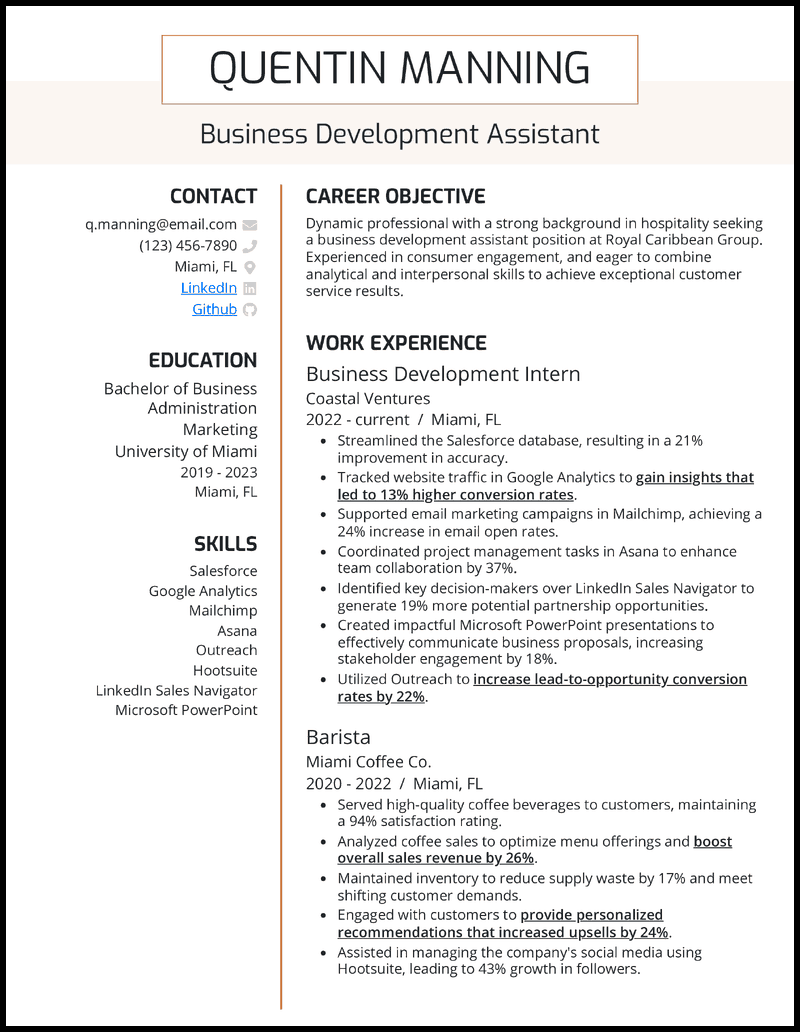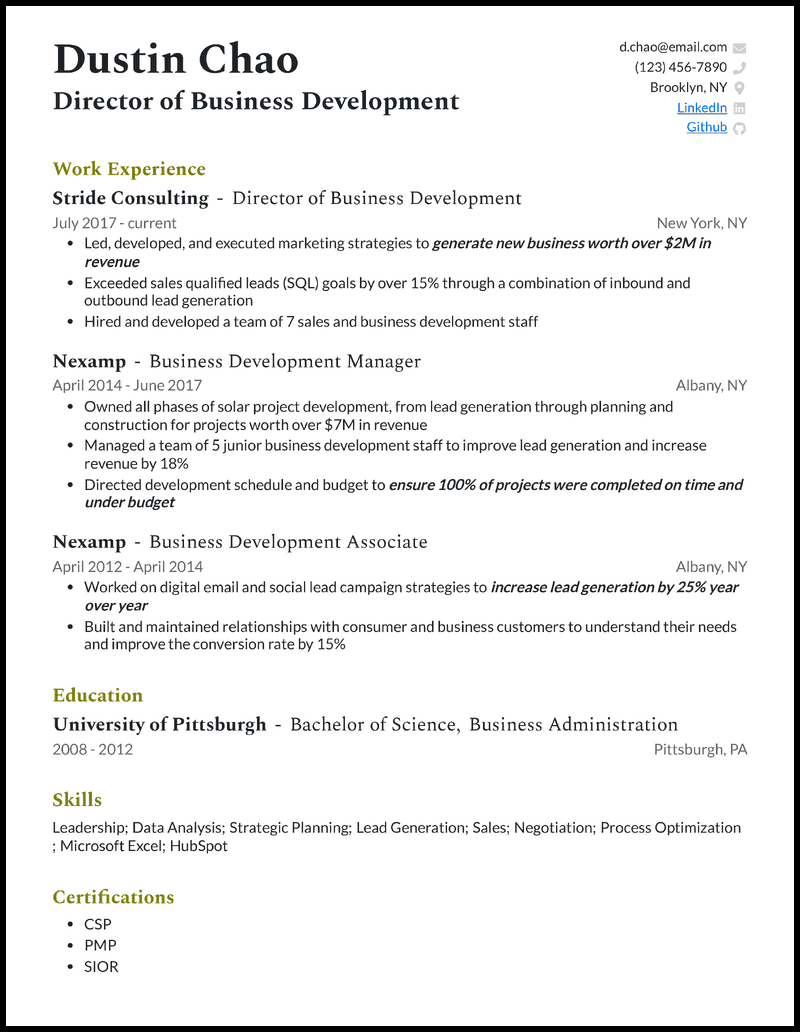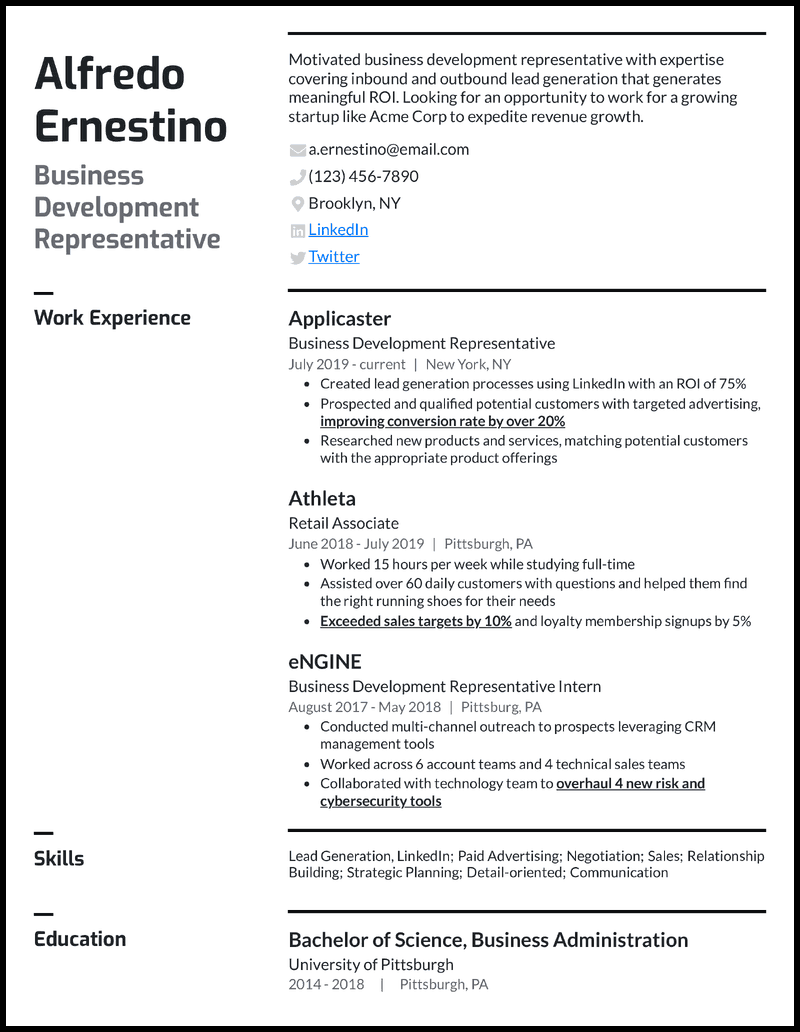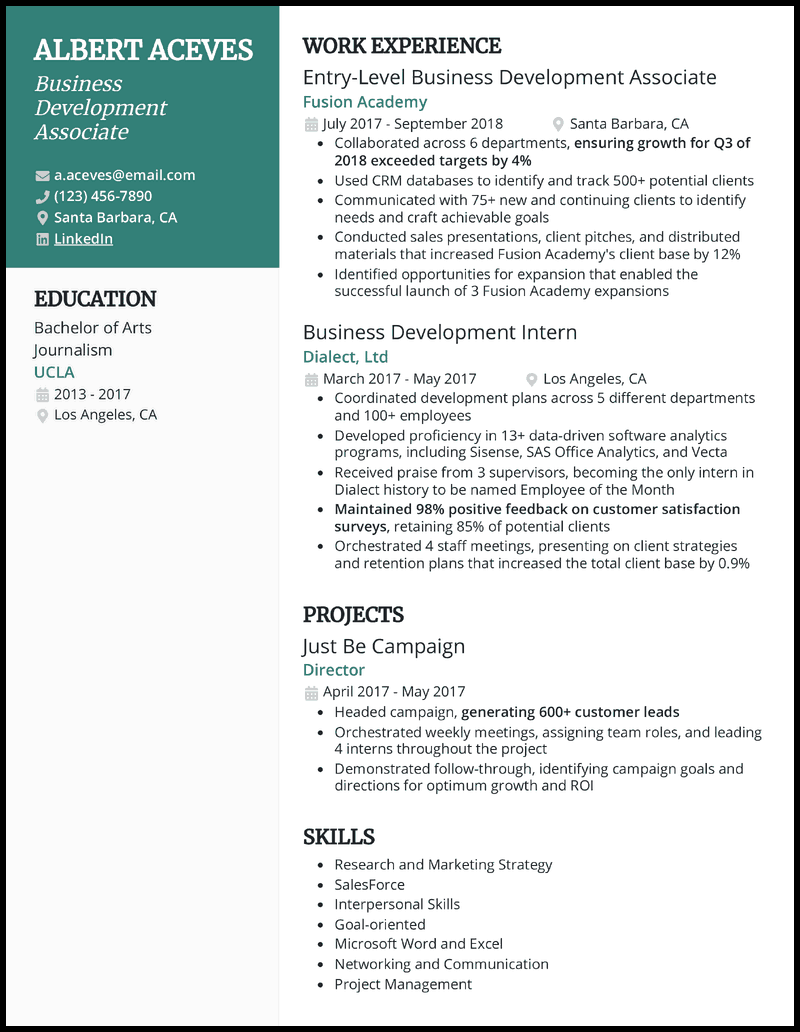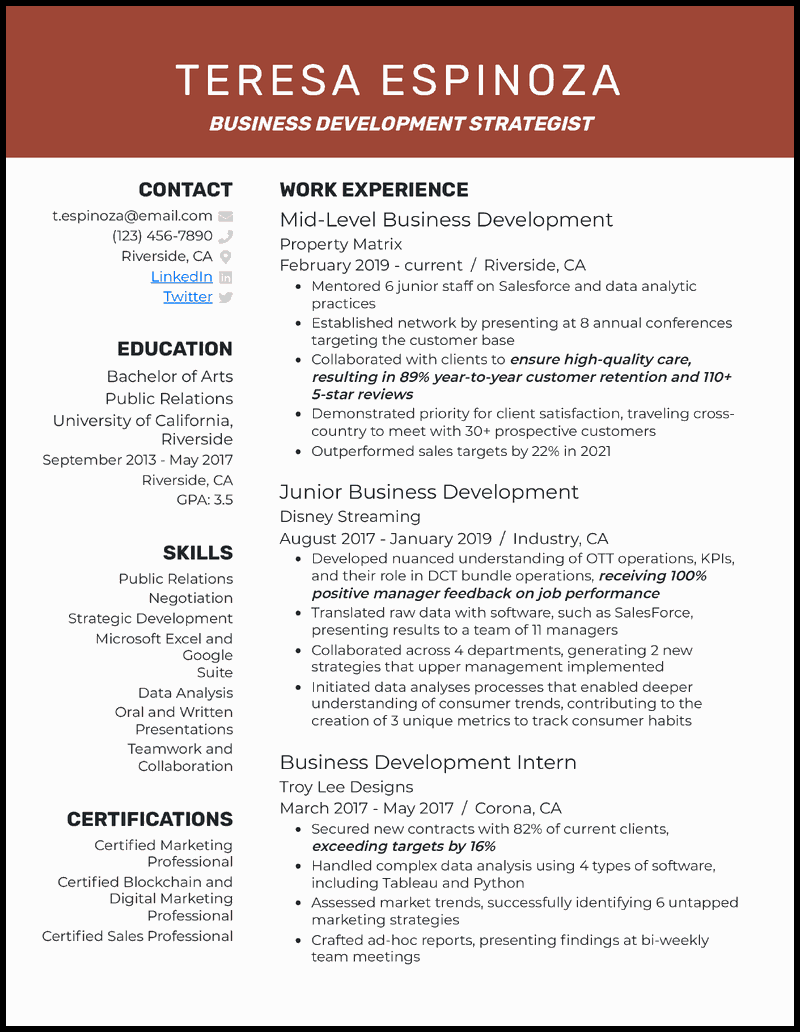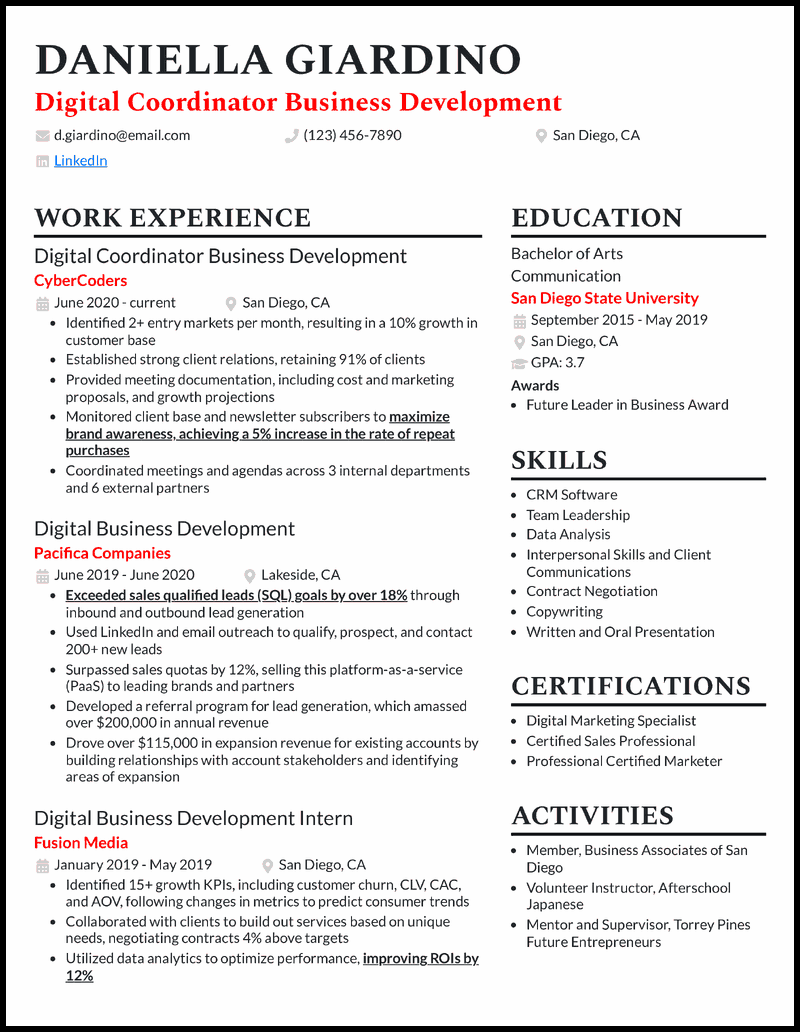Erwin Stevens felt a spark of enthusiasm at advancing to a new business development role: Ideally another managerial position like he’d worked since 2018, but with opportunities for fresh connections and networking within the industry. He sat at his laptop, realizing he’d need to update his resume.
Erwin knew good cover letter writing was essential to a lasting impression, too—especially at at managerial level. But he also knew some added research would pay off, and it definitely did once he found our time-tested resume tips! He felt accomplished as he updated his experience section with more recent achievements and checked out our business development resume examples, looking forward to his next job already.
If you want to make waves of your own as a business development professional—whether you have managerial experience or you’re entry-level—try our resources yourself to find success like Erwin!
Letting skills speak
- Recruiters are in for a candidate who perfectly fits into their needs and can start getting things done in their first day in office. And how to do make sure that’s you?
- Your relevant skills can shore up your candidacy and earn you a seat at the interview table. But you have to be strategic with how you get them noticed.
- Don’t just list the skills: Demonstrate how you used them and what you accomplished.
Show your determination
- There’s always a first for everything. Lack of experience in the job market is not anything to be shy about. Nevertheless, prospective employers expect something from you. It’s time to think outside the box.
- It could be you desire to learn first, keep up with trends, and put what you’ve learned into practice.
- That determination to succeed, if played well played, could the ace up your sleeves that gets you the call for an interview.
Filling the experience gaps
- Don’t let having one or two past jobs hurt your confidence. What your entry-level business development resume needs is a smart strategy to make it up for the lack of adequate experience.
- Fortunately, hobbies and interests that closely relate to the job can be your saving grace.
- Did you help found a students’ club? It shows your leadership skills. Add it. Did you play sport and helped your team win? You’ve the determination of a champ and recruiters would love that.
The right template wins
- There’s no doubt that you’ve made your make in your professional journey. It’s impressive. However, you have to find a way for all of your career juice to make it to your senior business development manager resume. The secret? Wait for it.
- Surprisingly, choosing the right resume template can never be overemphasized at such times.
- You need it (the template) to show and prove what you’re worth without creating clutter in your masterpiece. Your ultimate goal is to make it easy for recruiters to spot your strengths.
Let wins talk
- In the business world, you are either winning or losing. There’s no middle ground. Consequently, businesses are looking for winners to add to their teams.
- Are you a winner? Or even better, how can show that you got the chops to open profit floodgates?
- Quantifying your achievements with numbers is surefire way to get the attention of recruiters. A phrase like, “Boosting sales by $1.2m at AWeber by penetrating three international markets and driving a total of $870K in new business at Wawa Inc.” should have a place in your resume.
Use past roles as leverage
- Jobs you’ve held in the past are like building blocks that you can use to boost the chances of your application. If you play this smart, even unrelated roles can turn into powerful ammunition in your resume.
- Feels like a coffee barista role isn’t worth the shout out here? Use it to showcase your attention for detail, excellent customer relations, and the impact you made by increasing sales.
- Tying your past roles to your dream job tells recruiters you’re not a greenhorn but someone ready to hit the ground running.
Showcase tech savviness
- Helping hospital/medical centers grow means wearing two hats—one to develop patient-focused solutions and other for monetizing them reasonably. Ready to prove you can do both?
- All you have to do is include tools like HubSpot, Meditech Expanse, IQVIA, and ActiveCampaign in your healthcare business development resume to show employers you’ve already mastered the art of scaling healthcare businesses using technology and can do it again. Don’t forget to include these tools in your work experience bullet points to solidify your candidacy.
Impress with an elegant template
- Crafting a regional business development manager resume? Don’t apply without using a trustworthy design that can sell your story as well as your sell growth strategies.
- Here’s when our Elegant template is going to come in handy. It’s got everything you need and nothing you don’t. Ample space to include how you grew regional business in the past? Check! Separate section to include your tech-savvy business skills? Double check! Because let’s be honest, a good business developer knows that presentation does matter.
Leverage industry certifications
- The first step to mastering business development strategies is learning it professionally. That’s why your Bachelor of Business Administration deserves a prime spot in your resume.
- Not only does it reassure employers you’ve the academic backbone to back your business management skills, but it also helps you sidestep the dreaded ATS system. Still second-guessing things? Feel free to check your business development consultant resume using our AI-powered resume checker to make sure it ticks all the right boxes.
Competency in tools of trade
- Think of crafting your construction business development manager resume as building a bridge between expertise and opportunity.
- Walking the fine line between adding construction-specific platforms like Procore and Fieldwire and business tools, such as CRMs and collaboration software to get the best of both worlds. But don’t forget to specify and highlight how you used them to wear multiple hats and secure multi-million contracts.
Add relevant certificates
- Any professional certifications you hold are like badges of honor and a true reflection to your dedication to what you do.
- Don’t let them go to waste but instead deploy them to underline your hard-earned expertise.
- For instance, let’s say you’re a Certified Business Development Professional (CBDP)? Now it’s the time you let hiring managers know you’re a gem and companies will be scrambling to hire you. Sit and wait for the interview calls.
Show leadership
- You’re battle hardened and this new role is up in your alley. You’re confident that the position is for you to take.
- While you and your past employers know about all of it; you have to prove it to your future employer. And while at it, beat an equally qualified competition.
- About time to let loose your track record of leadership and success. Formatting your resume in the reverse chronological order, walk recruiters through your success and tested and proven leadership skills.
Turn to a career objective
- A career objective is something you don’t want to miss in your business development representative resume with less than two-year experience. Why?
- This is an opportunity to lay out your future plans and synchronize that with the vision of the company you’re applying to. It’s also a genius way to say, “I may not have much experience, but I’m already working on that”.
- Careful though. The objective needs to be not longer than 3 sentences. Be concise and leave lasting impression on recruiters.
Proving your impact
- If they already had the right person for the job, your prospective employer wouldn’t be out here hiring. This tells you they’re looking for a winner and you better fashion yourself as one.
- You may already have heard about it but doesn’t hurt to hear it again: proving impact can get you way ahead.
- Did you increase client base? Did customers leave glowing reviews? These and other KPI metrics deserve space in your business development associate resume.
No room for typos
- It takes a small slip and the chances of your application sailing through comes down tumbling. You don’t want that to be the fate of your business development strategist resume. Not if you can help it, anyway.
- When all work is done, sit down and go through your piece with a fine-tooth comb. One of the things you want to weed out are typos. Getting a second set of eyes from a friend or relative is recommended.
- And before you’re set to send, a final resume check can only do good to your chances of getting to the shortlist.
Choose the right format
- Nothing is cast on stone when it comes to the design of your resume. But that’s not to say you can ignore the cardinal rules when it comes to formatting a job-winning resume.
- Begin by choosing a template that will accommodate all that’s important for the hiring team to see. With everything put into a specific section, use bold, italics, and underline to cue in the recruiters about the most important deets.
- If possible, fit everything into one page. After all, brevity always plays to your advantage.
Deciding your resume design
- Do you have to go through the hassle of deciding which template is best for your business development executive resume? No, you don’t. Instead, you can use that extra time doing something else.
- From this collection of resume templates, you’re sure to get one that will turn your application into a trophy.
- Once that’s done, put everything where it belongs on the resume. In so doing, you’re giving recruiters an easy time, and they’ll reward you by paying more attention to your piece.
Let skills speak
- If you’re struggling to find the right words to describe your competencies, your international business development manager resume may be expressly bound for the trash bin.
- It doesn’t have to come to this. Not with the kind of experience and years of work you’ve put to build your stellar career.
- Ditch the words and in their place let skills take lead. Use them to say you’re the right fit for the job by demonstrating your use of industry-specific tools to get work done and achieving goals.
Related resume guides
Writing Your Business Development Resume

Formatting your business development resume correctly is more important than you might think. Good formatting ensures your resume is readable, logical, and complete. When your resume isn’t formatted well, it can be difficult for hiring managers to read, hard for ATS to understand, and just not visually appealing. Here’s a brief of what you should include in your business development resume to standout:
- Hook recruiters with an outstanding professional summary
- Showcase the most sought-after skills for a business developer such as being goal-oriented and pro-innovation
- Use reverse chronological format to detail your relevant and impactful experiences
- Utilize active verbs to strengthen your bullet points
- Add figures and data to underscore your measurable accomplishments
- Tailor your resume for the job description and role you’re after

Your resume format options
Applicants’ preferences for formatting change over time. in 2025, the most popular resume formats are reverse-chronological, functional, and combination/hybrid.
Specific pros and cons for each type of format:
- Reverse-chronological format: This format highlights your career growth by placing your most recent work experience at the top, leaving your oldest work experience (and likely, least relevant) at the bottom.
- Functional format: This format is all about highlighting your skills. It’s typically chosen by applicants with employment history gaps.
- Combination/Hybrid format: This format includes a reverse-chronological structure with equal weight between work experience and skills.
For business development resumes, we always recommend the use of reverse-chronological formatting. Although the combination format might seem like the best choice, it’s not common, so it can become confusing. Reverse-chronological is the preferred format for hiring managers due to its popularity, readability, and logical flow.

Your contact header information
You should list your name at the top of your resume in the header. Make sure to center it, and use the largest font (around 24-point). Right below your header, include the job title you’re seeking in a slightly smaller font (around 20-point font). Your header is also a great place to have some color, whether it’s for your font or as a pretty background.
On the right or left side of your resume, somewhere just below the header, you’ll want to include the following in a list using standard font size:
- Phone number
- City/state (optional)
- Professional links, such as LinkedIn (optional)
It can be hard to visualize what this will look like on your resume, so check out the visual below, or check out other resume examples for inspiration on achieving a professional yet visually appealing header.


How to ensure the ATS and recruiters read your resume
It’s not uncommon for a single business developer job posting to receive more than 200 applicants. Hiring teams couldn’t possibly give each applicant careful consideration, so they use ATS, aka applicant tracking systems. This software was created to help hiring teams during the explosion of online job applications.
Hiring managers use ATS to track keywords in your resume and match them to pre-selected words that the hiring team is seeking. If ATS doesn’t think an applicant is a good fit for the job, their resume can be thrown out before any person has a chance to read it.
Use the following techniques to ensure both ATS and recruiters can read your resume:
- Margins: Use standard one-half to one-inch margins.
- Fonts: Keep to the basic professional fonts; no cursive or hard-to-read script!
- Font size: Use about 24-point font for your name, 20-point font for your job title, and 10-12 point font everywhere else on your resume.
- Header names: Keep your font size the same for section headers and body text, but use bold lettering to make your headers stand out. You can also try using all caps to make your section headers easier to see.
- Skills: Ensure your skills are highly specialized to the business development job you’re seeking. Always check the business development job description to ensure you’ll have enough matching keywords (but never plagiarize).
- Logical order: Use reverse-chronological order because it’s the format ATS operates best with, and hiring managers tend to prefer it.
- One page: Ensure your resume is exactly one page.
Make the changes above while you’re building a resume to help you format your resume correctly for the ATS!

How to Write an Effective Business Developer Resume
We know that writing an effective resume can feel like a daunting task. However, it’s not that bad if you go section by section, which is what we’ll help you with in this guide.
We’d recommend having this article open in one tab and your resume in another, so you can go back and forth while making revisions. Now, let’s get into the bulk of actually writing your resume:
- Using a resume objective or summary statement
- How to include your work experience
- Choosing the right skills
- Education and certificates
- Customizations
- Proofreading your resume

Clearing the confusion: an objective or summary?
Many prospective business developers are rightfully confused by the resume objective and summary. What are they, why are they important, and when should you use one?
This section will answer all of those questions and give you some examples of both resume objectives and summary statements.
An objective is essentially an opening paragraph for your resume. It includes the job title you’re seeking, your years of experience, specific skills that make you a good candidate, and which company you’re applying for. Although objectives aren’t required, it’s a good idea to include an objective if you have limited work experience or are going through a significant career change.
On the other hand, a summary is a short synopsis of your work experience. The summary emphasizes your skills and how they were used at previous jobs successfully (using metrics). A summary is best-suited for applicants with at least 10+ years of experience in business development.
Let’s review a few examples of both strong and weak objectives and summaries:
- Bad objective example: Driven applicant with 2 years of experience. Seeking a job where my business skills will help the company thrive.
- Analysis: This objective does include years of experience, which is good, but it’s entirely too vague. Make sure you mention a specific job title, several particular skills, and the company’s name.
- Good objective example: Data-driven business developer with 3+ years of experience getting results for 2 start-ups turned Forbes Businesses to Watch. Seeking employment with GearStarter, where my expertise in CRM and process optimization can contribute to exponential company growth.
- Analysis: This objective is pretty good! It contains a specific job title, years of experience, job-specific skills, and a company name. Hiring managers would be instantly intrigued by this job candidate.
- Bad summary example: I have many years of experience in restaurant work and office roles, and with my good speaking and writing abilities, I am sure I will be a good fit at your company.
- Analysis: If your summary is this vague, leave it out entirely and add more work experience instead.
- Good summary example: Analytical business developer with 11+ years of experience collaborating with medium and large businesses, including 2 Fortune 500 companies. From CRM use, data analysis, lead generation, strategic planning, and more, I am confident that my skills in utilizing data-driven techniques and relationship building would boost the ROI for GoodFuel.
- Analysis: This summary is specific and demonstrates the applicant’s value through relevant metrics and skills.

How to include your work experience
Focus on including two to four job experiences on your business developer resume. We know it can be tempting to include every work experience you’ve ever had. Still, including irrelevant jobs from your teenage years isn’t useful when you have many years of relevant work experience. When you’ve held several job titles, be choosy about which two to four you include on your resume.

How to write your work experience descriptions
Make your work experience examples professional, interesting, and impressive. Use action verbs such as “spearheaded,” “orchestrated,” or “developed” to start each of your bullet points, and use active voice throughout (rather than passive). This will ensure that you take ownership of your resume and display confidence.
You also want to avoid personal pronouns, such as “me” or “I,” in your work experience. The hiring manager knows you’re writing about yourself, so avoid taking up the extra space and dooming your resume to the “unprofessional” pile. You’ll also need to decide on punctuation. You can either end all of your bullet points with periods or leave them off. It’s up to you; just be consistent. Finally, pay special attention to using consistent verb tenses. All of your past experience needs to be in the past tense, and you can choose whether you want to include your current experience in the past or present tense.
Here are some examples of good business developer resume bullet points that incorporate all of the above advice:
- Prospected and qualified potential customers with targeted advertising, improving conversion rate by over 20%
- Conducted multi-channel outreach to prospects by leveraging 3 forms of CRM management tools
- Developed marketing campaign featuring educational business material, resulting in $200K net profit

How to quantify your impact as a business developer
One of the most important things you include on your business development resume is metrics. Numbers showcase your job impact in a way that words alone cannot.
Aim to have metrics on at least 50 percent of your bullet points, but don’t be afraid to add more if you can. Here are some of the best ways to leverage metrics when you’re discussing your previous business development roles:
- Increased revenue: Arguably, increased revenue is the most important job of a business developer. Highlight how much you’ve increased gross company revenue during your tenure.
- Conversion rates: Have customer conversion rates gone up as you’ve adopted new systems for reaching customers? Did you use targeted advertising, answer questions within minutes or hours, or did you use multi-channel outreach to increase conversion rates?
- Leads: It’s not just important to tell hiring managers that you increased revenue. Tell them how you did it. Perhaps you reached 25 percent more leads through the CRM processes you’ve developed? Maybe you initiated a successful referral program? Or perhaps you’ve collaborated on building social media campaigns?
- Data analysis: It’s important to discuss how you’ve utilized data from CRM and related software to get results. Make sure you don’t neglect to mention how your data analysis has improved the ROI for acquisition at your company.
Using these types of metrics, we created work experience bullet points that could fit any strong business development resume:
- Crafted a holistic paid acquisition strategy, leading to a 38% ROI for every dollar spent
- Initiated data analysis processes that enabled a deeper understanding of consumer trends, contributing to the creation of 3 unique metrics to track consumer habits
- Launched Requests for Proposals (RFPs), collaborating with 19 contractors while meeting 97% of profitability targets and ROIs

How to choose skills for your business developer resume
You must choose the right skills on your resume if you want it to be seen by a hiring manager. A successful business development skills section provides insight into your areas of expertise and ensures ATS can find matching keywords on your resume.
Here are some of the best skills to include on your business development resume:
- ROI and Data Analysis
- Lead Conversion
- Sales Pitches
- Presentations
- Lead Qualification
- Relationship Building
- Tactful Communication
- Campaigns
- CRM Salesforce
- Leadership
We’d recommend mostly including hard skills, like “CRM” and “Sales Pitches,” because they’re job-specific, easy to quantify, and focus more on learned abilities. These are the types of skills that demonstrate a clear understanding of the job, and hiring managers actively seek these applicants. These resume skills are some of the best, most sought-after in the business development industry.
Soft skills, such as “time management,” “organization,” and “collaboration,” can play a supporting role in your skills section. They’re important, but harder to quantify and demonstrate, so you should include a few (but not too many) soft skills on your business development resume.

What to know about education, certs, and more
In the field of business development, there are no standardized job qualifications. However, many hiring managers will expect you to have a bachelor’s degree in a relevant field, such as business, management, or marketing. Some jobs may require applicants to hold an MBA or other graduate degrees, but that’s not the norm.
On the other hand, certifications are incredible inclusions on your resume. Though they’re often not required, Certified Marketing Professional, Blockchain and Digital Marketing Professional, Digital Marketing Specialist, and other credentials as shown in the example below can give you an extra edge with hiring managers.
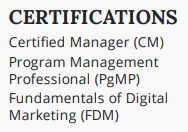
We typically don’t advise business developers to include interests and hobbies on their resumes, but there are some times when it may be appropriate.
A few pointers for when interests and hobbies may be appropriate for your resume:
- Consider including this section if you have minimal work experience. Interests, hobbies, and projects can stand in for work experience!
- Include unique interests and hobbies if your potential employer values individuality. (For example, a creative company like Nintendo would value knowing you like to sketch in your free time.
- Think about whether your interests, hobbies, or activities demonstrate a high level of commitment and focus. For example, hobbies such as Olympic Powerlifting prove that you’re a results-driven, focused, and dedicated person.
This candidate hints at soft skills with spot-on activities.


Tailor your business development resume to the job description and role
Remember to tailor your business development resume for every job to which you apply. It will help ATS recognize keywords and show the employer that you’re genuinely interested in the job. Pay special attention to customizing your resume objective or summary with a specific job title and company name.
Your skills section should also be customized, which you can do by carefully reading the job description. Finally, every bullet point you include should be carefully edited to highlight the most important skills and job duties listed in the job posting. Hopefully, you won’t have to make too many edits, but even if that is the case, this step is essential!

Edit and proofread your resume
You may be tempted to submit your business development resume the second you finish writing it, but stop for a second!
Give yourself a day or two to rest your eyes and brain so that you can proofread your resume with fresh eyes. Send it off to friends and family for edits before checking your resume for one final time. You may be surprised to realize you misspelled a few words or used inconsistent punctuation!

Well on Your Way to Your Next Business Development Job
You should be proud of yourself for reading through this entire resume guide! The hardest part of working on your resume is getting started, and now you’re ready to put in the work and get your dream business development job in 2025. Use our resume checker to upload your completed resume and check it against our AI-powered tips. On the other hand, if you haven’t started on your resume or want to begin from scratch, use our AI resume builder, which has built-in AI-powered tips and proper formatting to help set you in the right direction.





